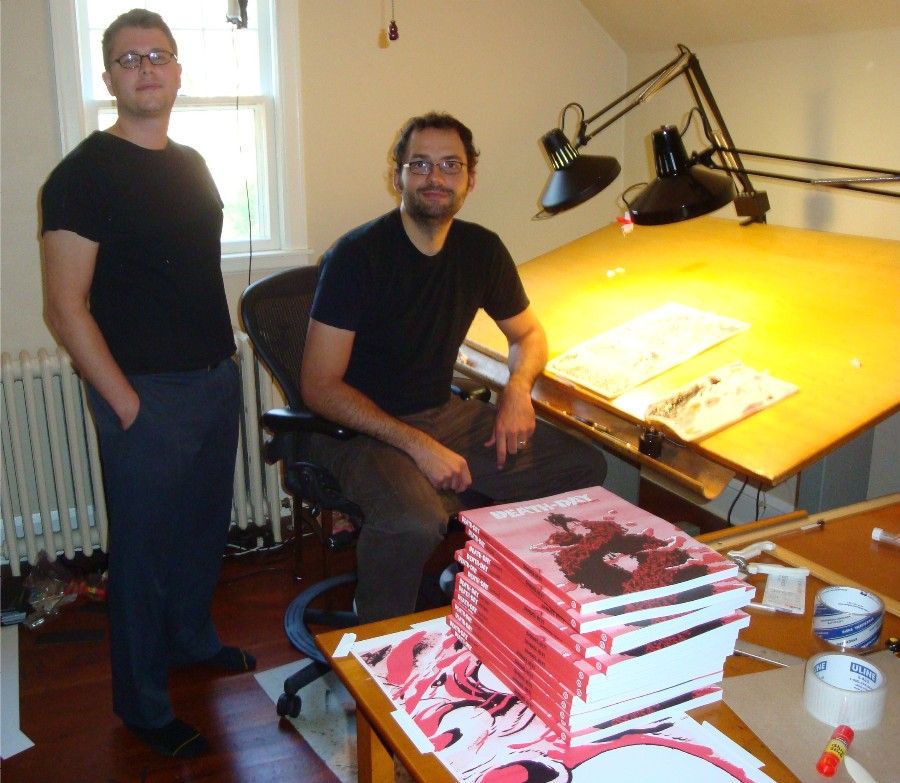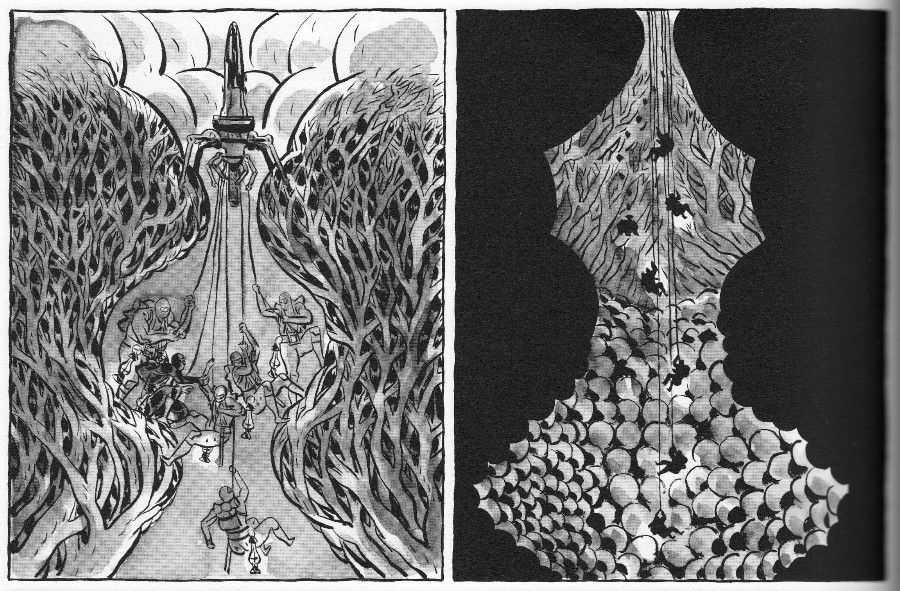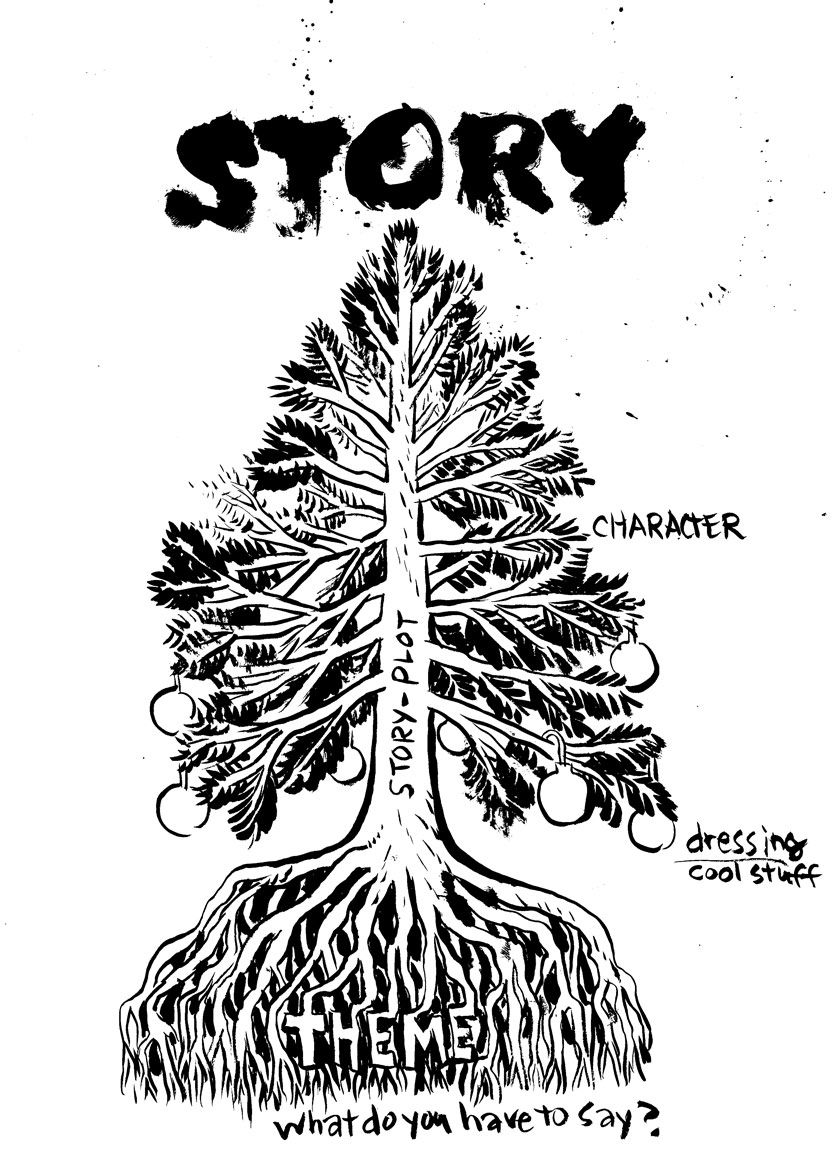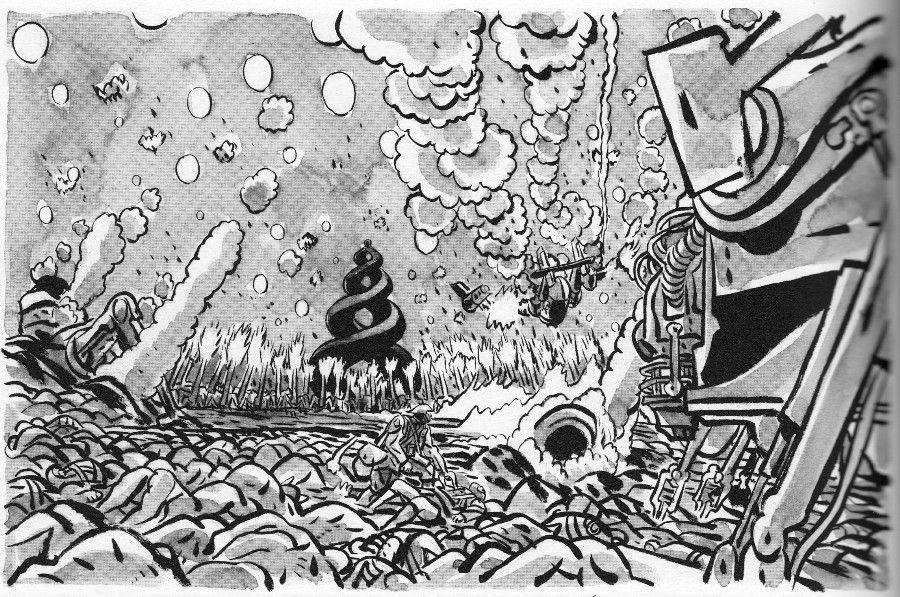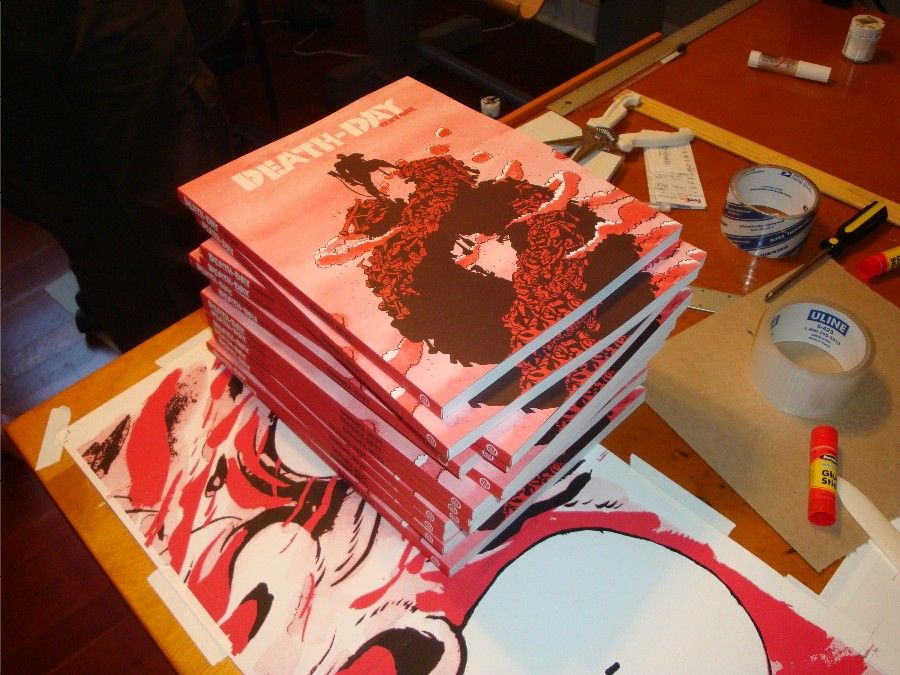When Sam Hiti won the Xeric Grant and self-published Tiempos Finales, Book One in 2004, the comics world took notice. A unique combination of influences from Central and South American art to manga and Jack Kirby came together with Hiti’s own, self-taught style to earn him praise and respect from fans, critics, and fellow cartoonists alike. All of who rubbed their hands together and impatiently waited for him to continue the story with Book Two.
Though Tiempos Finales, Book Two hasn’t appeared, Hiti certainly hasn’t been resting. In between gigs for folks like Nickelodeon (A Series of Unfortunate Events) and Lerner (Life in Ancient Civilizations), he’s been steadily producing mini-comics and art books like The Long Dark Train and Ghoulash. And he’s also been working on his current, big project, the webcomic Death-Day, which just saw its first collection last fall. If you're not familiar with it, there's a non-spoilery summary in my review.
What surprised some fans was that after producing so many comics completely by himself, Hiti’s name isn’t the only one on Death-Day. Joseph Midthun is listed as editor and co-creator of the series, so I sat down with both men to talk about the project, their collaboration, what they’ve learned along the way, and yes, the future of Tiempos Finales.
Michael May: Sam, tell me the story behind the title Death-Day.
Sam Hiti: Well, when I was a kid, I remember not knowing what the “D” in D-Day stood for. Instead of asking, I came to the conclusion that it must stand for Death, because of all the dead they showed on the television when they honored the anniversary. Later on in life when I had begun to make comics, I thought if I ever did a war story, Death-Day would make a great title for a book.
May: What was the inspiration for the book?
Hiti: The basic idea started to form after 9/11 and more so with the wars that followed. I had finished my first graphic novel, Tiempos Finales and was working full time on comics.
I remember walking home from my studio in downtown Minneapolis one night after work. I was waiting at a stop light and across the street, a building that I’d seen earlier in the day was now gone. It no longer existed. It was demolished and all that remained was a smooth surface of dirt. I thought about the people waiting alongside of me inside their cars at the lights. If this was their first time at this location they wouldn’t have known that the building ever existed. I was now carrying that building’s memory inside my subconscious. If I died without telling somebody about the building, would it be remembered? That concept planted the seed.
Another time I remember is when I was in Toronto for a comic convention. I was staying with my friend Kagan McLeod. We were talking about how grueling the process of making comics was and that after finishing a book you had to go through it all over again. I asked him why we chose to do this and his answer was, “Legacy.” I remember chuckling at him, but as much as I understood what he was saying, his answer struck a sour chord within me. The seed began to grow.
May: What are some of the visual influences you used (in terms of the uniforms, aliens, etc.)?
Hiti: I tried to play with a lot of things that I visually ingested as a child. Anything from cartoons to old war and sci-fi movies and TV shows. I don’t know where my fascination with Orbs came from, but looking back at Tiempos, they were in there too.
May: There was a pretty long development process for the book. What went into that?
Hiti: Well, it quickly turned from being a short story to a 200-page book. The problem was that I couldn’t figure out an ending that wouldn’t overtly explain the metaphor that I was trying to convey. At least, that’s what I thought the problem was. I probably did the book five times before the mini-comic version of the Prologue came out.
May: Is figuring out the ending why you brought in Joe?
Hiti: Sort of. Joe was living in the same apartment building as me at the time. I learned that he went to school for Film, so we got to talking about comics, movies, and story. I respected what he had to say, so I decided to show him an early draft of Death-Day. Slowly, he became part of the process and I drug him into my own personal hell. [Laughs]
Joe Midthun: Sam was floundering. It was all inked but he couldn’t finish it. He couldn't end the story. So I offered to help.
I figured the art is awesome; how hard could it be to come up with an ending that worked? [Laughs] We went through a process of moving art around and changing the format of the book. We even tried rewriting and adding new art. That took a few years before we realized it wasn't working. At that point Sam scrapped it and we started over from scratch.
May: Sam, what was it like collaborating with someone on such a personal story?
Hiti: It was difficult at times because we were both dealing with each other’s egos. But more so, I think I was hoping that Joe would have a magic solution to the ending that I couldn’t figure out. I should have been listening to what he was trying to teach me from the start and do the work the way it needed to be done instead of trying to use him as a crutch.
Communication (at least on my end) was very poor, but I respected Joe’s intelligence enough to try and work through it. I knew something was there and Joe challenged me technically, creatively, and internally. I’m thankful that he stuck with me.
I realize now that I had to go through the process of bettering myself as a human being before the story could end up on the thread that is now Part One of the series.
May: Joe, what was it like for you?
Midthun: It was hard at first, but it’s become a personal story for both of us.
I come from a film background. Every inch of a film print has been touched by a group of people. A lot of people make a movie happen: the grips, the boom operators, the craft service people, even projectionists. Film is a community effort. Collaboration is key.
Comics, especially independent/creator comics, are very different. Sure, you can do whatever you want, but you don't necessarily have someone there to keep you in check. That solo process can produce some cool results, but Sam wanted to hone his storytelling skills. It’s about trust, and that had to be built before we could move forward.
May: Do you feel your relationship to Death-Day is that of a co-parent or more of a midwife?
Midthun: I'm like Shiva to his Brahma. He creates; I destroy; yet we’re on the same team.
May: How did you put your fingerprints on it?
Midthun: That’s an interesting question! If at all: passively!
With all due respect, I think working on Death-Day has kind of been like having a kid. A baby is the product of two people, and you never know how it's going to turn out. It could have your eyes, or my hands…
I guess my point is: I’ve never actively tried to put my “fingerprints” on it. I’ve never tried to inject a style or a type of narrative that I can claim as my own. The colloquialism doesn’t really work for me. It makes me think of a burglar who wasn’t smart enough to wear gloves.
May: Sam, you told me earlier that the book tuned out to be more science fiction than you originally planned. How did that change come about?
Hiti: In order to build a story that worked, the idea had to be pulled out of the spiritual setting [that I originally created for it] and based in a world that the reader could relate to: a more organic place. That alone made it more sci-fi.
I believe that the goals of both spirituality and science should be after answering the same questions, “Who are we, what are we doing here, and why do we exist?” Science and faith should be joined at the hips; not two separate agendas.
Midthun: I don’t really see the story as science fiction. It’s just fiction. It’s artifice; a reflection of reality.
It’s hard to talk about it so early on – the first book is really setup – but I think the next book will really hit home…The setting and the scenario are purposeful and self-reflexive of the medium. It’s juxtaposed against a complex narrative structure that you don't usually find in mainstream comics.
Death-Day is a lot like life: complex and with no real order. We're trying to make a statement, not only on comics and through comics, but also on life itself. Sure, Death-Day deals with science and technology, but that’s only part of the story.
May: Death-Day started as a very spiritual story and Tiempos Finales was like that too. Sam, how has your storytelling style changed from then to now?
Hiti: I was invited to the C.S. Lewis conference in the UK in 2005 and there was a quote by Lewis displayed on the huge auditorium screen that deeply affected me. It said “We do not need more people writing Christian books; what we need is more Christians writing good books.” When I saw this it began to free me up as a creator, allowing me to not worry about telling what I believed, but to focus on telling a good story…as long as the story was worth telling.
My quest has been (and will be) to better understand how to convey my ideas through story. Joe’s made it clear to me that theme is the most important foundation to build a story upon. Good characters and story come from theme; everything else is just the icing on the cake.
Miyazaki-san said it best when he likened a story to a Christmas tree. He talked about how the roots of the tree are the theme and that you need a strong trunk, which is the plot or the story. The trunk of the tree then supports the branches (characters) and what you hang on the branches (cool ideas). Everything grows from a seed (an idea). The roots must be deep enough to stabilize a strong trunk, strong branches, and all kinds of ornaments and dressing.
I’ve come to realize that prior to this knowledge I was growing my tree backwards with everything I created. I was starting my stories by creating beautiful ornaments and then trying to grow my tree from the needles inward. It doesn't work. It only creates a mess.
May: It seems like you’ve moved from the way CS Lewis used his spirituality in his storytelling to more the way JRR Tolkien did it. Is that accurate?
Hiti: Yeah. I prefer the allegorical approach to spiritual themes better than making something like I did with Tiempos Finales. The problem with Tiempos is that I was taking a story and characters that already exist and twisting them to fit my own story. I couldn't be that creative with it because I was walking a thin line by messing around with what people believe. At what point was I going to cross the creative line and become disrespectful?
May: What makes Tolkien’s way more attractive to you?
Hiti: It allows the readers to see the story based on what they’re personally bringing to it when they ingest it for their own.
Midthun: I’m of the opinion that Sam uses allegory in his own way just like [Lewis and Tolkien] used allegory in their own way. The White Queen and Mordor have a lot more in common than Tolkien would have cared to admit. It’s just that a dude with a sword fighting orcs is way cooler than a talking lion. Who knows?!
May: Joe, how much influence do you think you had over Sam’s moving from more literal allegory to more symbolic?
Midthun: It’s like I said before. I’m not trying to get Sam to “bury his spiritual allegory” like Tolkien, although that has a nice passive aggressive Minnesota ring to it…I just challenge him to do better work. But it goes both ways; he challenges me too!
Tolkien was obviously obsessed, no? Lewis understood simplicity. I think it would have been awesome if they’d set aside their differences and collaborated on a book!
May: There are four volumes of Death-Day planned. When’s the next one due?
Hiti: We’re focusing on Part Two as a whole and it will be released as soon as it’s ready. I’ve gotten approval of the outline and am working on the timeline right now. Then the story will be broken down into episodes. This book might be bigger then the first, but if so, I’ll keep it at the same price point. After the episode breakdown gets approved, I’ll begin roughing out the whole book with my bic pen.
My deadline is to get part two out by the end of 2011. New episodes will appear online at the end of summer/early fall.
Midthun: For Part One, we wrote the story episode-by-episode. Sam would ink an episode and then we’d write the next one. Part Two is the start of the meat of the story, so we’re writing all the episodes at once. Then, Sam can just go to town on the art and episodes will come out online as he finishes them.
May: So the process is pretty smooth by now?
Hiti: It’s smoothing out. I’m learning how to better communicate with Joe. It’s been a joy to talk with him in theme and characters, instead of me forcing ideas and plot on him. We’ve built a great working relationship that will continue to grow. We’ve made it a point that it’s not about us; it’s all about the story.
Midthun: We've really hit a groove! Never underestimate the power of finishing something. It’s very inspiring! The process is the smoothest it’s ever been.
May: What about Tiempos Finales? Do you want to talk about future plans for that yet?
Hiti: I’ll come back to Tiempos Finales as soon as Death-Day is finished, but when I come back I’ll treat it as a new project. I’ll build the story from what I have learned; from the roots up.

